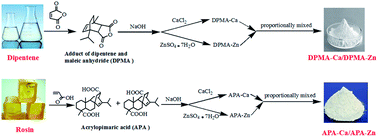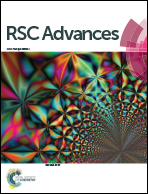Mixed calcium and zinc salts of dicarboxylic acids derived from rosin and dipentene: preparation and thermal stabilization for PVC
Abstract
Maleated dipentene (DPMA) and acrylopimaric acid (APA) were prepared by the Diels–Alder addition of dipentene with maleic anhydride and gum rosin with acrylic acid, respectively, and subsequently converted to the corresponding zinc salts (DPMA-Zn, APA-Zn) and calcium salts (DPMA-Ca, APA-Ca). Their chemical structures were confirmed by FT-IR analysis. The effects of the mixed DPMA-Ca/DPMA-Zn and APA-Ca/APA-Zn stabilizers on the PVC thermal stability were studied. In comparison, two commercial products, calcium stearate (CaSt2) and zinc stearate (ZnSt2), and two homemade salts of a dimer fatty acid (C36DA), zinc salt (C36DA-Zn) and calcium salt (C36DA-Ca), were also employed as controls in the study of PVC thermal stabilization. The thermal stability of PVC samples was determined using thermogravimetric analysis (TGA), Congo red test and discoloration test. Dynamic mechanical properties of the PVC compounds were also studied. The results showed that PVC compounds stabilized by the mixed DPMA-Ca/DPMA-Zn and APA-Ca/APA-Zn stabilizers displayed comparable modulus and glass transition temperatures but exhibited overall superior thermal stability compared with the CaSt2/ZnSt2 stabilized PVC.


 Please wait while we load your content...
Please wait while we load your content...